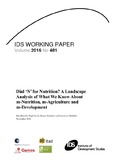| dc.contributor.author | Barnett, I | |
| dc.contributor.author | Scott, N | |
| dc.contributor.author | Batchelor, S | |
| dc.contributor.author | Haddad, L | |
| dc.date.accessioned | 2016-11-08T10:10:53Z | |
| dc.date.available | 2016-11-08T10:10:53Z | |
| dc.date.issued | 2016-11 | |
| dc.identifier.citation | Barnett, I.; Scott, N.; Batchelor, S. and Haddad, L. (2016) Dial ‘N’ for Nutrition? A Landscape Analysis of What We Know About m-Nutrition, m-Agriculture and m-Development, IDS Working Paper 481, Brighton: IDS | en |
| dc.identifier.isbn | 978-1-78118-342-7 | |
| dc.identifier.issn | 2040-0209 | |
| dc.identifier.uri | https://opendocs.ids.ac.uk/opendocs/handle/20.500.12413/12642 | |
| dc.description.abstract | Child undernutrition is one of the most devastating realities in many parts of the world. Globally in 2015, 159 million children below the age of five years were too short for their age (stunted) and 50 million were too thin for their height (wasted). Inadequate nutrition in early childhood can have lifelong consequences, including poor physical and psychological health, and low educational attainment and employment opportunities.
Behaviour change of child carers is central to the effectiveness of many interventions addressing child undernutrition. For example, early and exclusive breastfeeding and the complementary feeding of infants between six and 23 months requires changes in feeding, caring and playing with children, as well as changes in the types and frequency of foods consumed and their preparation.
Agriculture is probably the sector with the most studies on the effectiveness of nutrition-sensitive interventions. For agriculture to become more nutrition sensitive, choices will need to be made about who controls resources, which crops and animals are farmed, the types of storage and processing patterns adopted, and the metrics used to assess interventions. All of these changes are embedded in long cultural traditions and are not necessarily straightforward to change.
If behaviour change is difficult, can the rapid rise of mobile technology help? A number of m-agri and m-health interventions exist, and m-nutrition interventions are increasingly being developed. The number of high-quality studies that look at whether mobile technology interventions help behaviour change is small, but is likely to increase quite rapidly with rising mobile penetration rates and declining costs.
The purpose of this paper is to assist would-be implementers and evaluators to understand the landscape they are operating in, so they can design nutrition and agriculture interventions that stand the greatest chance of working, and evaluation designs that stand the greatest chance of finding answers rigorously. | en |
| dc.language.iso | en | en |
| dc.publisher | IDS | en |
| dc.relation.ispartofseries | IDS Working Paper;481 | |
| dc.rights | Where stated, reproduction of certain figures within the report has been granted by the figures' original publishers. Permission must be sought from the original owner(s) before reusing these figures. | en |
| dc.rights.uri | http://creativecommons.org/licenses/by-nc/4.0/ | en |
| dc.subject | Agriculture | en |
| dc.subject | Nutrition | en |
| dc.subject | Technology | en |
| dc.title | Dial ‘N’ for Nutrition? A Landscape Analysis of What We Know About m-Nutrition, m-Agriculture and m-Development | en |
| dc.type | IDS Working Paper | en |
| dc.rights.holder | IDS | en |
| dc.identifier.team | Health and Nutrition | en |
| rioxxterms.funder | Default funder | en |
| rioxxterms.identifier.project | Default project | en |
| rioxxterms.version | VoR | en |
| rioxxterms.funder.project | c941507f-fd0b-4fc3-9822-4b2132f61a1d | en |


